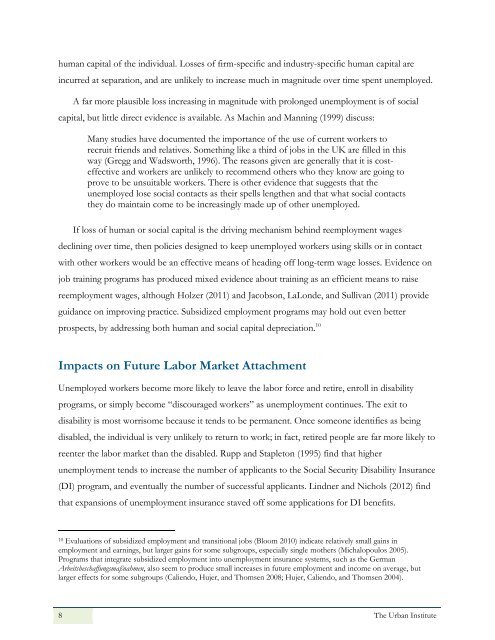Hidden Unemployment
Hidden Unemployment
Hidden Unemployment
You also want an ePaper? Increase the reach of your titles
YUMPU automatically turns print PDFs into web optimized ePapers that Google loves.
human capital of the individual. Losses of firm-specific and industry-specific human capital are<br />
incurred at separation, and are unlikely to increase much in magnitude over time spent unemployed.<br />
A far more plausible loss increasing in magnitude with prolonged unemployment is of social<br />
capital, but little direct evidence is available. As Machin and Manning (1999) discuss:<br />
Many studies have documented the importance of the use of current workers to<br />
recruit friends and relatives. Something like a third of jobs in the UK are filled in this<br />
way (Gregg and Wadsworth, 1996). The reasons given are generally that it is costeffective<br />
and workers are unlikely to recommend others who they know are going to<br />
prove to be unsuitable workers. There is other evidence that suggests that the<br />
unemployed lose social contacts as their spells lengthen and that what social contacts<br />
they do maintain come to be increasingly made up of other unemployed.<br />
If loss of human or social capital is the driving mechanism behind reemployment wages<br />
declining over time, then policies designed to keep unemployed workers using skills or in contact<br />
with other workers would be an effective means of heading off long-term wage losses. Evidence on<br />
job training programs has produced mixed evidence about training as an efficient means to raise<br />
reemployment wages, although Holzer (2011) and Jacobson, LaLonde, and Sullivan (2011) provide<br />
guidance on improving practice. Subsidized employment programs may hold out even better<br />
prospects, by addressing both human and social capital depreciation. 10<br />
Impacts on Future Labor Market Attachment<br />
Unemployed workers become more likely to leave the labor force and retire, enroll in disability<br />
programs, or simply become “discouraged workers” as unemployment continues. The exit to<br />
disability is most worrisome because it tends to be permanent. Once someone identifies as being<br />
disabled, the individual is very unlikely to return to work; in fact, retired people are far more likely to<br />
reenter the labor market than the disabled. Rupp and Stapleton (1995) find that higher<br />
unemployment tends to increase the number of applicants to the Social Security Disability Insurance<br />
(DI) program, and eventually the number of successful applicants. Lindner and Nichols (2012) find<br />
that expansions of unemployment insurance staved off some applications for DI benefits.<br />
10 Evaluations of subsidized employment and transitional jobs (Bloom 2010) indicate relatively small gains in<br />
employment and earnings, but larger gains for some subgroups, especially single mothers (Michalopoulos 2005).<br />
Programs that integrate subsidized employment into unemployment insurance systems, such as the German<br />
Arbeitsbeschaffungsmaßnahmen, also seem to produce small increases in future employment and income on average, but<br />
larger effects for some subgroups (Caliendo, Hujer, and Thomsen 2008; Hujer, Caliendo, and Thomsen 2004).<br />
8 The Urban Institute

















